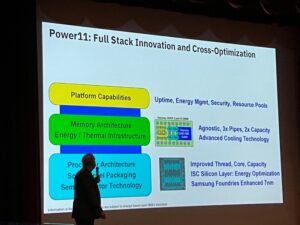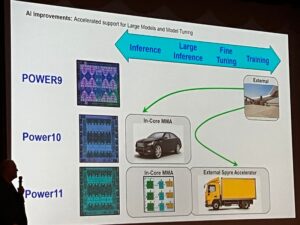The Power11 generation of IBM Power Systems is scheduled to launch in Q3 of 2025. During this year’s COMMON POWERUp conference in Anaheim, California, we got the inside story on the technologies, architecture, and features that IBM i users can look forward to in Power11.
This year’s keynote session was presented by Bill Starke, Chief Architect for Power Microprocessors and IBM Distinguished Engineer. Having worked for IBM for over 30 years on successive generations of our favorite IT platform, Starke gave us an exclusive and valuable look at Power11 and beyond.
IBM Power processor roadmap 2025

Starke and his team at IBM are committed to continuous platform innovation and leadership. “Every generation makes adjustments by looking at where workloads are going,” he explained.
For the previous generation, Power10, that meant getting ready for our current AI era. The big new feature in the Power10 processor was the matrix math accelerator (MMA), a specialized piece of silicon that’s directly integrated into the processor to speed up AI inferencing.
Now, in Power11, they are building upon and extending that architecture while also adding valuable new features and optimizations.
Full-stack innovation and cross-optimization

At the bottom of the stack, the IBM Power processor team has been hard at work on the processor’s architecture, socket-level packaging, and semiconductor technology. This has led to breakthroughs in performance and blazing fast clock speed.
For instance, by introducing an extra layer of silicon to the processor, they have created an innovative energy management solution that allows the hardware to get more performance out of less energy. In today’s computing era, energy and thermal controls are becoming more important than ever, so we were glad to see this improvement take shape.
That’s all on top of better core strength and higher core counts that let the new generation of processors handle even bigger workloads.
“We took everything good about Power10, and we turned it up to 11,” said Starke.
Thermal infrastructure and memory architecture
One step above the processor on the hardware stack, work on chiplet-based technology has led to new innovations in advanced cooling tech. By finding new ways to package components like heat sinks and heat pipes, Power11 has a better thermal management profile than previous generations.
With cooling costs accounting for up to 40% of a data center’s overall electricity bill, that’s a big deal.
Additionally, the way the processor interfaces with the server’s memory is also getting a boost. The Power11 processor is ready to run with the latest OMI DDR5 memory, but at the same time it’s also memory-agnostic and backward compatible.
This has benefits on multiple fronts. “As DRAM tech evolves, we can integrate with them. But Power11 is also compatible with DDR4,” the previous generation of DRAM memory, explained Starke. That means companies can choose to optimize for either improved computing performance (upgrading to the latest and greatest) or financial return (getting a longer lifespan out of existing technology).
Either way, Power11’s architecture will prove advantageous for handling large, memory-intensive workloads. Between a 3x bandwidth improvement of 1200 GB/s DRAM per socket, a 2x boost to capacity of 8 TB DRAM per socket, and a 30% increase in system cohesion flow of 1000 GB/s per socket, IBM is raising the ceiling for the kinds of extreme workloads businesses can run on Power Systems and IBM i.
Platform capabilities
Finally, at the top of the stack, we have improved platform capabilities. One of the most exciting innovations for cloud providers like CloudFirst is a new uptime feature that enables Power Systems to perform planned maintenance without needing to reboot. This will go even further in helping us provide our customers with a 100% uptime high-availability solution for mission-critical IT infrastructure.
Add to that the new security features and hypervisor resource pools that make Power11 particularly strong at virtualization, and it’s easy to see how businesses that continue to invest in IBM Power technology will be able to maintain their confidence in IBM i and the larger Power platform for years to come.
AI acceleration

It’s no surprise that IBM continues to invest in Power’s AI capabilities. According to Starke, the team is set on providing “all the right tools to have the best-of-breed AI platform.”
In the Power9 generation, IBM partnered with NVIDIA to enable connectivity to external GPUs. Then in Power10, the company introduced the in-core MMA we discussed above. Now, with Power11, they’ve held onto the integrated MMA while introducing a new external IBM Spyre accelerator chip that’s designed to help companies get the most out of their AI investments.
“At IBM, we’re about solving business problems,” explained Starke. Not many IBM users are training their own gigantic AI models. Instead, they’re deploying existing models, integrating them, and inferencing them on an ongoing basis. They don’t necessarily need a massive GPU cluster.
This is what made Power10’s MMA such a great fit for IBM i users, and it’s why IBM is carrying this tech forward into Power11. Because the MMA is directly integrated into the processor, it provides much lower latency than interconnecting with an external GPU would.
The right tool for the job
Ultimately, it comes down to having the right tool for the job, and Starke gave us a great analogy to conceptualize this.
Imagine you needed to go buy some groceries for your household. If all you had access to was a cargo plane, that wouldn’t be very efficient. It’s overkill, and you’d be a lot better off just driving a car. However, if you were moving across town, then you’d be better off renting a cargo van than driving a car so you wouldn’t have to make a ton of trips.
Applying this logic to AI, only having the external GPU of Power9 is like the cargo plane example. For businesses more interested in inferencing than in training AI models, it’s way too much. That’s why IBM built the MMA, which is like a car—great for everyday use. But now, with those workloads growing even larger, those same customers may need a little extra juice, and that’s where the Spyre Accelerator comes in, which is like the cargo van.
The final notch in the belt here is that they made the Spyre Accelerator attach through the PCIe slot in Power11’s architecture. While only certain models of Power9 could equip NVIDIA GPUs, every single Power11 product will be compatible with the Spyre Accelerator. That means that if your business’s AI needs grow a few years down the line, you’ll be able to upgrade easily.
“The Power11 system is the ultimate investment protection,” concluded Starke. “The AI you want to use one day may not be invented yet, but you’ll be able to plug it into Power11.”
Access the latest IBM Power Systems with CloudFirst
Upgrading to a new generation of Power Systems hardware can be costly, complicated, and time-consuming. It doesn’t have to be that way. When you run IBM i on the cloud with CloudFirst, we handle everything for you.
From provisioning the hardware to migrating workloads to staying up to speed with the latest cybersecurity updates, CloudFirst is constantly improving our data centers to make sure our customers get instant access to the best technologies that IBM has to offer. We then integrate that with Windows and Linux machines so your entire IT infrastructure runs smoothly and seamlessly.
Don’t wait for your on-prem servers to hit end-of-life to start a conversation. Request a quote today.

